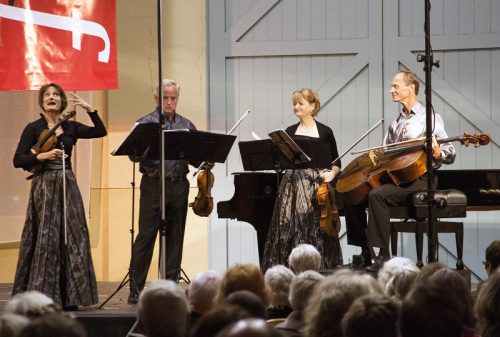DANIEL de Borah began yesterday’s “Brahms at Twilight” with a performance of Brahms, Three Intermezzi for Piano from Op. 119.

Helene Pohl (violin), Douglas Beilman (violin), Gillian Ansell (viola) and Rolf Gjelsten (cello). Photo Judith Crispin
The opening adagio, with its chime-like gestures and sombre lines, highlighted de Borah’s light tone and considered rubato. While de Borah produced a lovely lullaby quality in the andantino un poco agitato, he was ill served by the acoustic of the venue, which narrowed the piano’s timbral range. Moving into the final Grazioso e giocoso, de Borah’s effortless touch and controlled dramatic contour brought the work to a confident close.
Joined by mezzo-soprano Hannah Fraser and violist Gillian Ansell, de Borah was understated and elegant in his performance of Brahms’s Two Songs Op. 91 for alto, viola and piano. Ansell’s lyrical cedar tones and controlled timbral shifts from the viola brought pathos to the work. Mezzo soprano, Fraser, balanced a lovely sense of line with simple ornamentation. She produced a number of exquisite lower notes, but some vanished into the texture. Fraser brought fuller, sombre tones to match underlying harmonic tensions —all to great dramatic effect. A number of rather strange theatrical gestures, clasping at the heart and so on, made Fraser’s performance a little curious, a little awkward—but did not detract from her fine singing.
The highlight of this concert was, for me, a stellar performance of Brahms’s String Quartet No. 3 in B flat, Op. 67 by Helene Pohl (violin), Douglas Beilman (violin), Gillian Ansell (viola) and Rolf Gjelsten (cello). In the humorous opening Vivace, the quartet maintained freedom of line with carefully rehearsed rubato. Sotto voce passages grew into legato, agitato, and to false climaxes that vanished again into nothing. Expertly, the ensemble brought emotional subtleties out of an ever-shifting harmonic landscape. Pohl’s artistic vibrato and shimmering top notes were breathtaking, as were Gjelsten’s rich timbres.
Pohl continued to shine in the melodies of the stately Andante. Harmonic changes, from suspensions and shifting inner voices, were beautifully balanced with pedal notes in cello and viola—like hymns or chorales giving way to pure colour. Beilman and Ansell controlled the slow internal dramaturgy of this movement with mastery.
Gjelsten and Ansell produced exquisite viola and cello tones in the 6/8 Agitato (Allegretto non troppo)—Trio—Coda, especially in the more rhapsodic phrases. Pizzicato gestures shaped the line and retained a dance-like quality even in the most emotionally desolate passages. In typical Brahmsian fashion, the prevailing light-hearted dance gesture drops periodically into the depths, only to resurface with a mid-line tierce de picardie and bright clear cadences.
Pohl, Beilman, Ansell and Gjelsten were all magnificent in the final Poco allegretto con variazioni, a Mozartian set of variations on the cusp of dignity and catastrophe—like all Brahms, this movement evokes something barely restrained beneath a glassy surface. Clever tonal transitions and easing harmonic tension brought the work to a satisfying close. It was a real pleasure to hear the obvious affinity for Brahms and clear understanding of his harmonic language that underpinned this performance by Pohl, Beilman, Ansell and Gjelsten.
The post Review / Affinity for Brahms appeared first on Canberra CityNews.